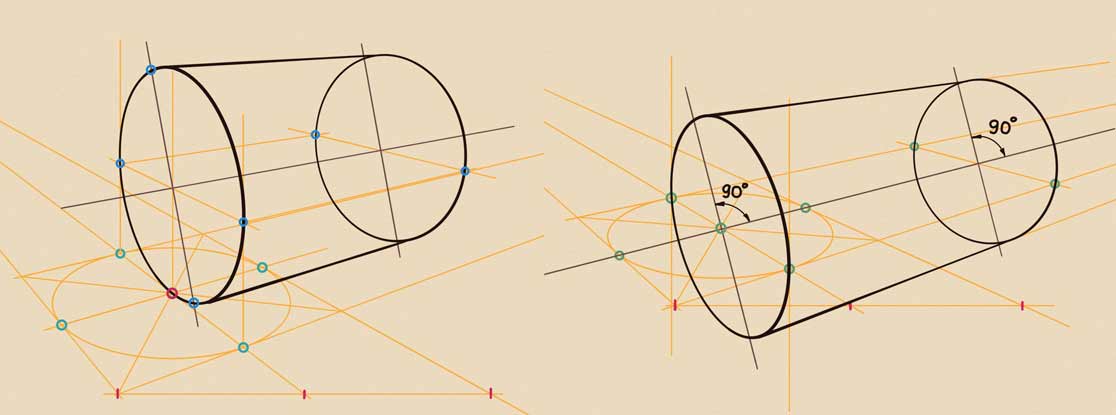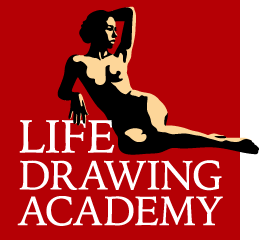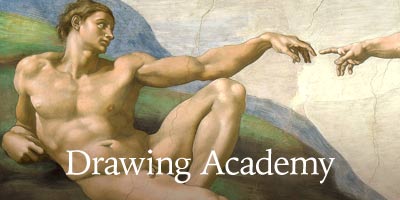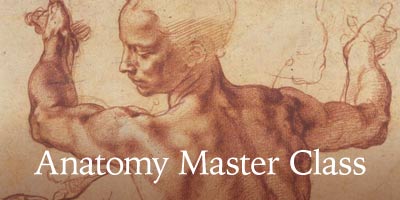Video by Vladimir London, a Life Drawing Academy tutor
Enroll in the Life Drawing Academy now!
How to Draw Reclining Cylinders
Video by Vladimir London, a Life Drawing Academy tutor

In this tutorial, I will show you several methods of drawing reclining cylinders. Let's begin with the simplest case, a one-point perspective.
The horizon line is marked at the top, which means that the cylinder is seen from above. There is one vanishing point on the horizon. By the way, the horizon is always at eye level. The front and back circles of this cylinder are depicted as perfect circles. Due to foreshortening, the back side is smaller. Its dimensions are dictated by the vanishing lines, which converge to the vanishing point. Two side outlines connect the front and back planes of this cylinder.
Let's make another drawing of a reclining cylinder in one-point perspective. This time, we will see it sideways. Once again, the horizon level is at the top and there is only one vanishing point on that line. Like in the previous case, I will inscribe a cylinder inside a square prism. How to draw cuboids is explained in depth in the Life Drawing Academy Correspondence Course.
One-point perspective is uncomplicated. The challenge comes when we need to use a two-point perspective. It seems that inscribing a cylinder into a square prism is a good way to go. Let's see why it is not the best approach. Here's a perfect prism reclining on a horizontal surface. Both vanishing points are located on the horizon, but the right one is beyond the drawing area, which is fine as long as the vanishing angles are correct. The central axis of this prism goes through points where diagonals of squares cross each other. The axes of two ovals are perpendicular to this central axis. Each oval is inscribed into its square, touching the corresponding square in four points, marked in green. Two side outlines are connecting the opposite ovals. So, this object looks like a sound cylinder. Let's check it from another angle. After rotating this drawing upward, you can see that the ovals are not horizontal, but tilted. This is a classical mistake mentioned earlier. This drawing is also asymmetrical. The correct lines are marked in green here.
Now, what to do to avoid such mistakes. One of the main rules is that the axes of ovals must be perfectly perpendicular to the central axis. The ovals must be fully symmetrical along the central axis. If we turn this cylinder upward, you will see that it looks right. So, once again, the angle between axes must be 90 degrees. I will repeat this exercise, drawing two more cylinders at other angles of view. The principle is simple, but perspective is questionable.
To solve this challenge, I will show you a very special way of drawing a cylinder in a two-point perspective. This is my know-how and no art college teaches that method. The point of view will be from above, so the horizon is located above the cylinder. I will use the same two vanishing points as in the first case. The left one is visible and the right point is located beyond the drawing area. Both of these points are on the same horizon. Check out how to divide the depth in perspective.
A horizontal square is depicted in this two-point perspective. We know it is a square, not a rectangle, because a perfect ellipse can be inscribed into this shape. Four green points are touching each side of this square in the middle of each side. The central axis goes through the center of this oval. It points into the right vanishing point. Another axis is perfectly perpendicular to the axis of symmetry. The angle is 90 degrees. Now, let's use the dimension marked in blue. It is the width of the horizontal ellipse. The width of the cylinder will be equal to this dimension. Two vanishing lines define the side outlines of that cylinder. The opposite side will be elliptical as well. The green dots define the outline of the back oval. Its axis is perpendicular to the axis of symmetry. Two side outlines complete this cylinder drawing. Now, let's check how this cylinder looks when standing upright. It is symmetrical and its ovals are correct.
Although the demonstrated method works well, it does not tell where the cylinder touches the ground until we actually draw a cylinder. I will now show you another know-how, which solves this question. This method is also unique and I developed it for the Life Drawing Academy Correspondence Course students. I will use the same point of view as in the previous case. The horizon level is at the top and there are two vanishing points. I divide the depth in half. This division is marked in red. Once again, I draw a square in perspective and check it by inscribing a perfect ellipse inside. This time, that square will be not in the middle of a cylinder, but on the ground. So, we know where the cylinder will touch the ground. The dimension marked in blue is used to plot the cylinder's axes. The width of the oval on the ground will be equal to the width of this cylinder. At the bottom, the cylinder will touch the ground. Its two axes are perpendicular. Red dots define the cylinder's oval. These dots are located on the axis and on the vanishing line. I will mark the 90-degree angles here. Two side outlines are pointing to the right vanishing point. Two red dots on another vanishing line help to plot the back oval. Now, let's check how this cylinder looks when standing upright. It is fully symmetrical and sound. I hope you learned a few things about how to draw cylinders in perspective. To get strong skills of constructive drawing, enroll in the world's best drawing course.
To learn good drawing techniques, enroll in the Life Drawing Academy course:
Online Course
A self-study, self-paced course for you to learn fundamental methods of classical drawing and improve life drawing skills by watching video lessons and doing assignments
- Unlimited access to 52 life drawing video lessons
- Lifetime membership without deadlines
- Unlimited support from the Academy tutors
- Constructive critique of your artworks
- Member access to the Academy's Art community
- Place in the Academy's Students Gallery
- Exclusive members-only newsletter and bonuses
- Life Drawing Academy Diploma of Excellence in your name
One-time payment - Lifetime membership
$297 USD
Personal Tutoring Online + Online Course
The ultimate choice if you who would like to receive personal, one-to-one tutoring from the Academy teachers, which is custom-tailored to your skills and needs
- Everything in Online Course, plus:
- Dedicated team of art tutors
- Assessment of your current level of drawing skills
- Personalized curriculum tailored to your skills and goals
- Up to 100 drawing tasks with by-task assessment
- Unlimited one-to-one personal coaching with detailed per-task instructions and feedback
- Artwork critiques and results-oriented guidance
One-time payment - Lifetime membership
$997 USD




